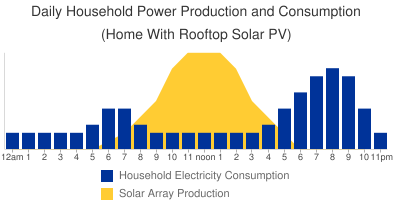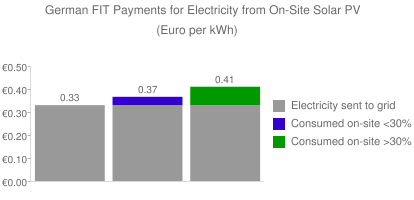It’s rarely mentioned that a home with a solar array still gets most of its electricity from the grid. In fact, without storage, a typical home solar array might only serve one-third of a home’s electricity use, even if the system is big enough to meet the home’s peak needs.
 The problem is a mis-match in production and consumption, with a rooftop solar array producing most of its electricity during daylight hours, when the occupants aren’t home. The problem often gets overlooked in the United States, because our on-site energy generation policy – called net metering – simply totals up the homeowner’s total consumption for a month and subtracts out their solar electricity production over the same period (hence, “net” metering).
The problem is a mis-match in production and consumption, with a rooftop solar array producing most of its electricity during daylight hours, when the occupants aren’t home. The problem often gets overlooked in the United States, because our on-site energy generation policy – called net metering – simply totals up the homeowner’s total consumption for a month and subtracts out their solar electricity production over the same period (hence, “net” metering).
With the world’s largest solar PV market and most sophisticated renewable energy policy, the Germans have developed a tool – roughly translated as “own consumption” – to increase the amount of solar electricity used on-site.
To understand “own consumption,” it’s necessary to briefly describe the German renewable energy policy: the awkwardly named but fantastically successful feed-in tariff. This policy requires utilities to connect every renewable energy producer to the grid and purchase all their output at a flat, attractive rate on a long-term contract. It’s responsible for more than 3 gigawatts of solar PV being installed in just three months in 2010 (ten times as much as the entire U.S. installed in 2008). Their success has inspired Ontario, Vermont, and Gainesville, Florida, to adopt feed-in tariffs, and has inspired interest in feed-in tariffs among several of the largest municipal utilities in the country (Sacramento, San Antonio, and Los Angeles).
 With revisions to their 2010 feed-in tariff, the Germans hope to increase the portion of distributed renewable energy generation that is used on-site. This “own consumption” provision provides higher prices for electricity that is produced and consumed on-site. In 2010, a German homeowner with a solar PV array is paid 3.6 euro cents – in addition to the 33 euro cents for the base feed-in tariff price – for every kilowatt-hour consumed onsite, for up to 30 percent of the system’s production. But the more interesting component of “own consumption” is the higher price – an 8 euro cent bonus per kilowatt-hour – for on-site consumption above that first 30% of system production.
With revisions to their 2010 feed-in tariff, the Germans hope to increase the portion of distributed renewable energy generation that is used on-site. This “own consumption” provision provides higher prices for electricity that is produced and consumed on-site. In 2010, a German homeowner with a solar PV array is paid 3.6 euro cents – in addition to the 33 euro cents for the base feed-in tariff price – for every kilowatt-hour consumed onsite, for up to 30 percent of the system’s production. But the more interesting component of “own consumption” is the higher price – an 8 euro cent bonus per kilowatt-hour – for on-site consumption above that first 30% of system production.
Because the German feed-in tariff encourages individuals to maximize the size of their solar arrays, many homeowners new to the program will receive the own consumption bonus simply because their rooftop solar modules produce (on average) three times the electricity used in the home. But getting the higher, 8-cent bonus will require greater efforts. German homeowners may have to invest in smart appliances, timed to operate when the solar panel is producing sufficient power, or they could invest in batteries to store electricity for use when they are home or during nighttime hours.
Unlike net metering, which is simply an accounting tool to let people reduce their energy bills, or the feed-in tariff (which encourages distributed energy production sold to the grid), own consumption will reward producers for using the electricity they produce.
It may take a few iterations to smooth out the wrinkles.
For one, a third meter is required to measure “own consumption,” at a substantial cost to the homeowner: 200 euro. Additionally, higher on-site consumption would likely require a significant financial investment in storage or smart appliances. It remains to be seen whether it would make sense for a consumer to pursue the additional own consumption incentive, because the cost of earning it may outweigh the financial costs of attaining the incentive.
It may not be perfect, but the Germans have a knack for perfecting their energy policies over time. And in conceiving of a policy to encourage greater on-site consumption, Germany has again established itself as a policy leader on distributed generation.
Hat tip: Much of the information in this post derived from Craig Morris’ excellent series on peak demand parity in Germany.


